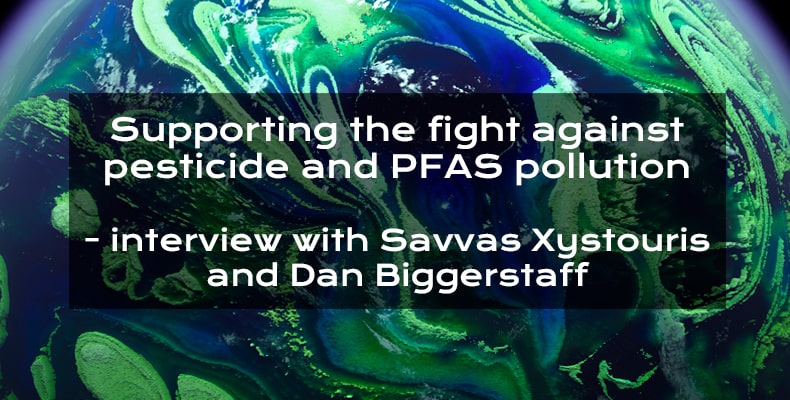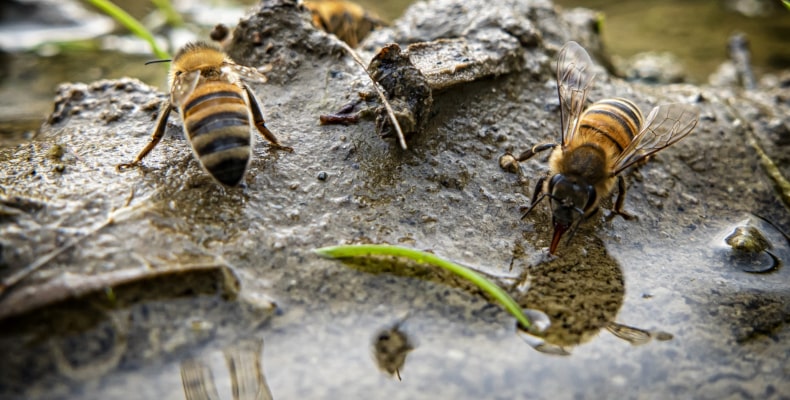Supporting the fight against pesticide and PFAS pollution

Man-made environmental pollutants like PFAS and pesticides are now on the public and regulatory agenda more than ever before. As well as presenting a hazard to our watercourses, food supplies, pollinators and overall health, they also threaten to overwhelm our capacity to assess and monitor them. But can combining analytical and proficiency testing help laboratories to turn the tide? And what are the innovative new products that can help our analysis? We asked two of our expert scientists - LGC AXIO Proficiency Testing’s Savvas Xystouris and Dr Ehrenstorfer’s Dan Biggerstaff - to tell us more.
What’s your assessment of the current pesticides and PFAS situation?
Savvas Xystouris (SX): I’m a chemist, and chemicals have brought many benefits to society. But I think we can all accept that we are in trouble. Overusing chemicals for a long period of time is obviously causing harm to the environment, and consequently to us. The challenge is to be able to maintain the balance between the benefits from the chemicals we’re using – pesticides or PFAS, or whatever – and minimise the undesirable effects.
Dan Biggerstaff (DB): You have to have pesticides or we couldn’t really produce enough food to feed the world population, so they are absolutely necessary. We scientists try to do the toxicology, and determine what the safety thresholds of the pesticides are. At what level do they become dangerous to what type of species? But sometimes, it’s not until there’s been a very long exposure that some of the risks start becoming apparent. For example, one of the big issues in the US right now is glyphosate, and glyphosate is now being shown to cause cancer. Yet it was kind of ubiquitous, and everyone said it was safe for – what? – about 20-30 years? You could buy it in the hardware store to kill your grass, or whatever. There are compounds that may not exhibit a high toxicity at first that can end up having health effects that were unanticipated. That’s where the science is constantly re-evaluating, and looking at data so we can make the necessary adjustments as new information comes out.
AXIO has just released a white paper on neonicotinoids (NNIs). Can you tell us more?
SX: Our White Paper, first of all, explores not only what neonicotinoid pesticides are, but how they are classified. One of the key things about them is that they are systemic pesticides, which are taken up by the plant and transported throughout it: into the leaves, flowers, roots, and stems, as well as pollen and nectar. It makes them different to contact pesticides that remain on the surface of the treated parts of plants, such as the leaves. We also discuss how neonicotinoids are prevalent in the environment, and that all the scientific research is saying that. They’re stable as well – they pass into the aquatic system and have the potential to be toxic, not just to bees. We quote a review of the literature – of 29 studies from nine different countries – which found that neonicotinoids were detected in the majority of the waters tested. That was also irrespective of the type of water, so whether it was river water, or drinking water. The white paper also outlines a monitoring strategy for the measurement of NNIs, with some information about the analytical methodology. Typically, you’d use methods like gas chromatography with different detectors, and liquid chromatography coupled with mass spectrometry. We also discuss how solid phase extraction is widely used for sample preparation and how mass spectrometry helps to achieve better sensitivity when it comes to the compounds of interest.
And why has AXIO launched a new NNI groundwater proficiency testing sample?
XS: Obviously, it was the discussion around neonicotinoids and the fact that they are now banned (in the European Union, with a US decision on whether to ban or restrict expected soon). The European Food Safety Authority compared the expected levels of NNI pesticides to which the bees are likely to be exposed in the environment, and those that actually cause effects in bees – and they came to the conclusion that there is a risk to bees that should be taken into account. The legislation around NNIs focuses on restricting them in order to protect insects that are not targeted by the pesticides, and so the sample (PT-AQ-66) helps with the quantitative determination of the five major compounds (clothianidin, imidacloprid, thiamethoxam, acetamiprid, and thiacloprid) in groundwater. It’s an expansion of our AQUACHECK scheme that’s been monitoring water quality and safety since the mid-1980s. The sample is made up of a 10ml spiking solution, together with groundwater for the five compounds, with instructions about how to proceed with dilutions and the analysis.

What do you think about the upcoming Environmental Protection Agency (EPA) decision on banning or restricting neonicotinoids?
DB: From my observations of the EPA, they tend to move a whole lot slower than the EU. I don’t know if this is about the regulatory framework, or maybe a legal framework, but they almost can’t make regulations against something unless the toxicology has actually been demonstrated. Then they base all their decisions off the toxicological data, as opposed to the precautionary principle.
But isn’t 2022 supposed to be a year of ‘laser focus’ on PFAS at the EPA?
You know, PFAS is a perfect example of that kind of caution. Yes, the EPA put some limits on PFOS (perfluorooctane sulfonic acid) and PFOA (perfluorooctanoic acid) because there actually is toxicological data available for those two specific compounds. But there are over 3,000 different PFAS compounds out there in the environment, in production, and in use, and there’s no toxicological data on those. So there’s no meaningful regulation to deal with these compounds as a broad class, yet we know they’re bio accumulators. The latest conference I went to on them said it takes about eight to 12 years as the turnaround time in the body, depending on the types of PFAS they are. So, when you get an exposure, you know it’s going to take eight to 12 years to get rid of it. But you know you’re getting exposed to more, and the rate coming in is faster than the rate going out, so they’re definitely accumulating in our bodies.
So what are the AXIO and Dr Ehrenstorfer products that can help labs keep up with all these environmental pollutants?
DB: Our Dr Ehrenstorfer PestiMix can really help. We were starting to see a very broad range of custom pesticide requests from the food safety industry. So we started developing a set of standards that ended up having about 850 analytes in it, split between five different solutions, in order to calibrate our instrumentation for all of these different pesticides very quickly, and be able to QC our products against those.
Making those standards available commercially as PestiMix means our customers can, very quickly, do a one to one dilution and end up with a calibration set that's got 800-850 analytes on it. What’s more, they can make it in a matter of about 10 minutes, get it on the instrument, and get it running. And every day, they can generate a brand new calibration, which really helps save time for the laboratory. We work with some food safety labs that had an entire team of chemists just managing their reference materials. They would either start with either neat materials or singles, or some mixtures of solutions, and spend days making their working standards. With our PestiMix kits, they’ve got five solutions, as opposed to potentially hundreds of smaller solutions to have to track – so the amount of documentation is drastically reduced. You’re always guaranteed to have a good value on them, and you don’t have to worry about biasing your data high because your standard is degrading and giving a poor response.
It's a great product, for sure. But what can AXIO PT samples add to that?
SX: Well, even when they’re using PestiMix, labs also need to participate in a quality assurance programme like proficiency testing to ensure that the measurement results their method produces are reliable - and that the analysis provides the accuracy and specificity they need. Because, even if they use the best reference materials mixtures, if the method is not reliable it can lead to wrong decisions and the wrong input into risk assessment, for example. The primary objective in participating in PT is to help assess the validity of the laboratory’s routine testing. And then you can use the data from the PT scheme to demonstrate your competency to customers and the authorities, and compare your performance with other labs around the world. You can also use the data to educate staff and help them to verify methods. And that’s why we offer a wide variety of PT samples for pesticides in food products, such as fruits and vegetables, cereals and even green tea. I’m talking about food because that’s one of my areas of expertise, but we offer a very wide range of water and environmental samples as well.
So using high quality RMs and PT together is a full solution for pesticide testing labs?
DB: I would say that definitely gives you your best chance. People can always make mistakes, but using reference materials and PT together really helps minimise the risks.
We’ve covered a lot of ground there. Thank you, Savvas and Dan, for such a full and expert discussion of the issues around PFAS and pesticide analysis.
Participating in a proficiency testing programme such as the AXIO AQUACHECK scheme is essential in ensuring that the NNI testing methods in your laboratory are both fit for purpose and properly implemented - and for giving you confidence in the measurement of your results.
For 40 years, AXIO has been a trusted partner for laboratories working to keep food safe for everyone.
We move with the world’s changing demands, which is why we’ve launched our ground-breaking new neonicotinoids in groundwater sample (PT-AQ-66). It’s supplied as a 10ml spiking solution and 2x 1-litre groundwater samples, with clothianidin, imidacloprid, thiamethoxam, acetamiprid, and thiacloprid as the target analytes. Drawing on decades of proficiency testing and our truly global reach, AXIO is your perfect partner in proficiency testing.
Head to lgcstandards.com/AXIO to find out more and place your order.
Dr Ehrenstorfer has consistently led the industry in pesticide reference materials for almost fifty years, and can supply an extensive range of pesticide products, including PestiMix and 47 neonicotinoid RMs.
|
